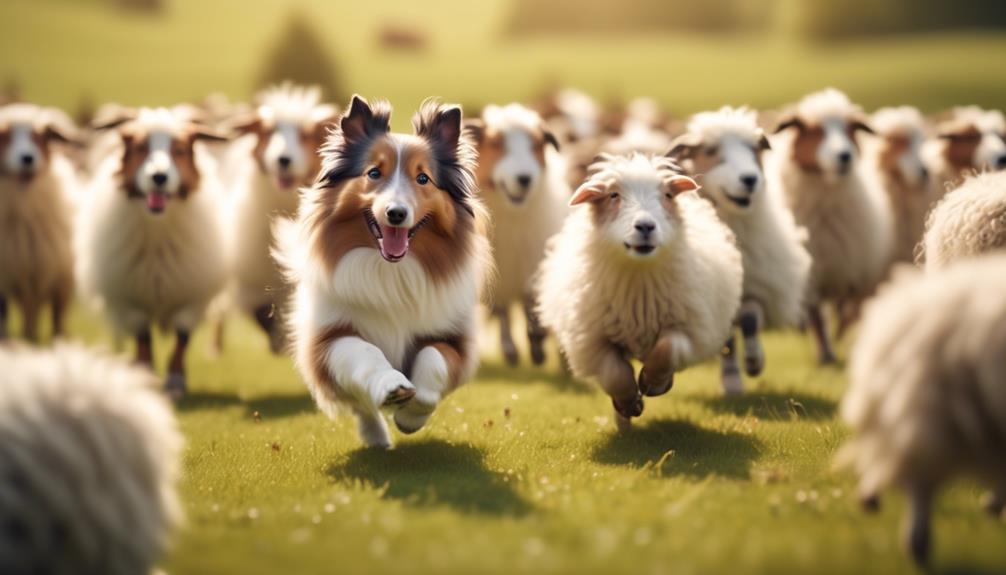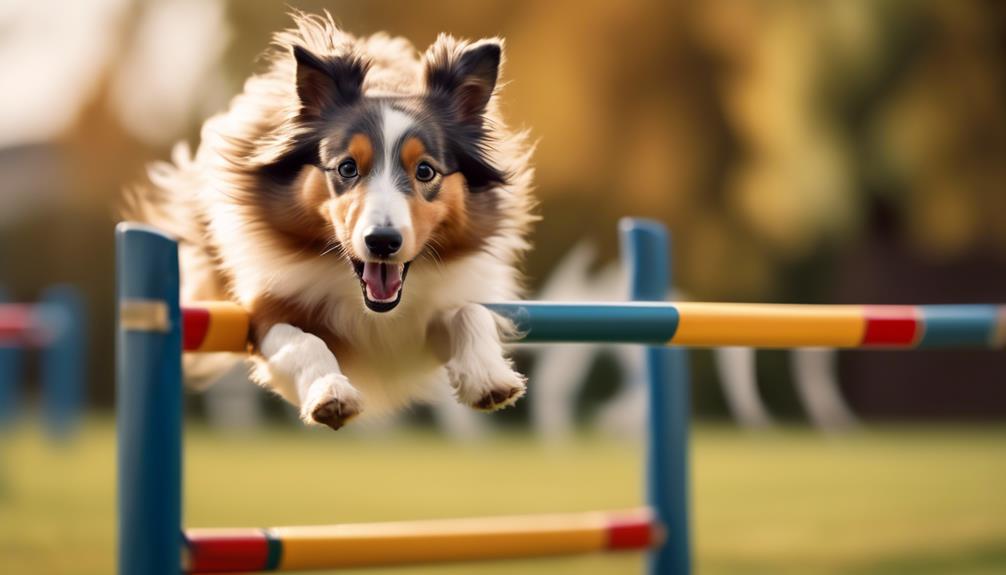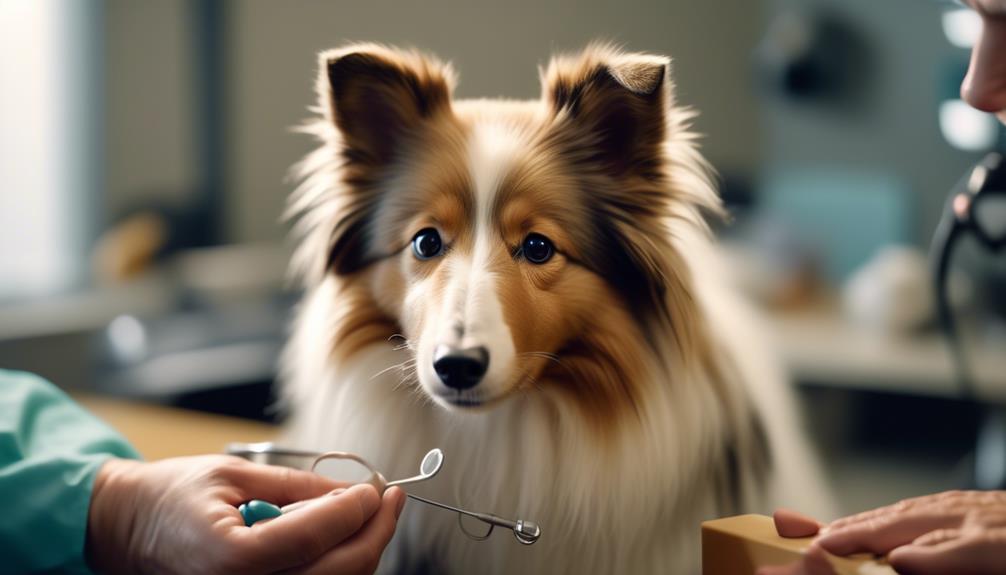
Are you ready to embark on a journey to discover the hidden treasures of the Shetland Sheepdog? Like a captivating book waiting to be unraveled, this breed holds a world of information and characteristics that will leave you intrigued.
From their fascinating origins in the scenic Shetland Islands, to their intelligence and unwavering loyalty, the Shetland Sheepdog is a breed worth exploring.
So, grab a metaphorical ticket and get ready to embark on a captivating adventure into the world of the Shetland Sheepdog, where you’ll uncover their unique traits, exercise needs, grooming requirements, and so much more.
Key Takeaways
- Shetland Sheepdogs are intelligent, affectionate, and loyal dogs known for their herding instincts.
- They require moderate exercise, regular mental stimulation, and positive reinforcement training.
- Shetland Sheepdogs have a long double coat that requires regular grooming to prevent matting.
- They are prone to certain health issues and require regular veterinary care and a balanced diet.
Origin and Size
The Shetland Sheepdog, originating from Scotland’s Shetland Islands, is a small to medium-sized breed known for its intelligence and loyalty. Weighing around 14-27 pounds (6-12 kg), they have a lifespan of 12-14 years.
With a long double coat and dense undercoat, they come in various colors, including sable, black, and blue merle. Shelties are intelligent, affectionate, and loyal, making them great companions. They have herding instincts and can be cautious around strangers but are generally good with families.
Moderate exercise is necessary to keep them happy and prevent boredom. Shelties are highly trainable and excel in obedience and agility. Their sharp minds make them highly adaptable and capable of handling advanced tasks.
Regular grooming is needed for their long coat, and they may be prone to certain health issues. Providing a nurturing environment and a balanced diet are crucial for their overall well-being.
See another Dog breed profile.
Shiba Inu Dog Breed
Lifespan and Coat

With a lifespan of 12-14 years, the Shetland Sheepdog is known for its long double coat. This beautiful coat consists of a dense undercoat and comes in various colors, such as sable, black, and blue merle, often with white markings. The Shetland Sheepdog’s coat requires regular brushing to prevent matting, as well as occasional baths and grooming. To give you a better idea of the Shetland Sheepdog’s coat colors, here is a table:
| Coat Colors | Description |
|---|---|
| Sable | Shades of golden to mahogany with darker tips |
| Black | Solid black |
| Blue Merle | Marbled gray-blue with black patches |
| White Markings | Commonly found on the chest, neck, feet, and face |
The Shetland Sheepdog’s long, flowing coat adds to its charm and beauty, making it a beloved breed among dog enthusiasts.
Temperament and Exercise Needs

Now let’s explore the temperament and exercise needs of the Shetland Sheepdog, a breed known for its intelligence and loyalty.
Shetland Sheepdogs are intelligent, affectionate, and loyal companions. They’ve strong herding instincts and may be cautious around strangers. However, they’re generally good with families and make excellent companions for children.
When it comes to exercise, Shetland Sheepdogs have moderate exercise needs. Regular walks, playtime, and mental stimulation are important to keep them happy and prevent boredom. They excel in obedience and agility, making them ideal candidates for dog sports and competitions.
Their sharp minds make them highly adaptable and capable of handling advanced tasks. So, make sure to provide them with enough exercise and mental stimulation to keep them content and healthy.
Training and Sports

To effectively train and engage a Shetland Sheepdog, incorporate a variety of sports and activities into their routine. These intelligent and eager-to-please dogs excel in obedience and agility, making them ideal candidates for dog sports and competitions.
Here are four sports and activities that can keep your Shetland Sheepdog physically and mentally stimulated:
- Obedience Training: Shelties are highly trainable and thrive on learning new commands. Teaching them obedience skills not only strengthens your bond but also provides mental stimulation.
- Agility: Shetland Sheepdogs are agile and love to run and jump. Agility training allows them to showcase their natural abilities while challenging their physical and mental capabilities.
- Flyball: This fast-paced team sport involves running, jumping, and retrieving a ball. Shelties enjoy the excitement and competition of flyball and excel in this sport.
- Herding Trials: Since Shelties have herding instincts, participating in herding trials allows them to showcase their natural abilities and work alongside their handlers.
Mental Stimulation and Grooming

Engaging in mental stimulation activities and maintaining a regular grooming routine are essential for the well-being and happiness of Shetland Sheepdogs. These intelligent and adaptable dogs thrive when their minds are challenged and their coats are well-cared for. Mental stimulation can be provided through interactive toys, puzzle games, and obedience training. This not only keeps them entertained but also helps prevent boredom and destructive behavior. Grooming-wise, Shetland Sheepdogs have a long double coat that requires regular brushing to prevent matting. Occasional baths and grooming sessions are also necessary to keep their coats clean and healthy. Here is a table summarizing the importance of mental stimulation and grooming for Shetland Sheepdogs:
| Mental Stimulation | Grooming |
|---|---|
| Prevents boredom and destructive behavior | Keeps coat clean and healthy |
| Challenges their intelligent minds | Prevents matting and tangles |
| Can be provided through interactive toys and puzzle games | Requires regular brushing |
| Helps maintain their well-being and happiness | Occasional baths and grooming sessions are necessary |
Health Issues and Veterinary Care

Taking care of the health and well-being of your Shetland Sheepdog is essential for their overall quality of life. Here are some important considerations regarding their health issues and veterinary care:
- Regular Check-ups: Schedule routine veterinary check-ups to ensure early detection and prevention of potential health problems.
- Vaccinations: Keep your Shetland Sheepdog up to date on vaccinations to protect them from common diseases.
- Grooming: Maintain proper grooming practices, including regular brushing, to prevent matting and skin issues.
- Nutritional Needs: Provide a balanced diet and monitor their weight to prevent obesity-related health issues.
Balanced Diet and Ethical Breeding

Maintaining a balanced diet and supporting ethical breeding practices are crucial aspects of responsible ownership for Shetland Sheepdogs.
Providing your Sheltie with a nutritious and well-rounded diet is essential for their overall health and well-being. Make sure to feed them high-quality dog food that meets their specific nutritional needs, including protein, carbohydrates, fats, vitamins, and minerals. Avoid feeding them excessive amounts or unhealthy treats that can lead to weight gain and health issues.
Additionally, when looking for a Shetland Sheepdog puppy, it’s important to choose a reputable breeder who prioritizes the health and temperament of their dogs. Ethical breeders provide a nurturing environment for the puppies and conduct proper health testing to ensure the offspring are healthy and free from genetic diseases. By supporting ethical breeding practices, you contribute to the betterment of the breed and help prevent the proliferation of unhealthy or poorly bred dogs.
Nurturing Environment and Apartment Living

To provide a nurturing environment for your Shetland Sheepdog in an apartment setting, focus on creating a comfortable and stimulating living space. Here are four tips to help you create the ideal environment for your furry friend:
- Provide plenty of exercise opportunities: Although Shetland Sheepdogs adapt well to apartment living, they still require regular exercise to stay happy and healthy. Take your dog for daily walks, play games, and engage them in mental stimulation activities.
- Create a cozy space: Designate a specific area in your apartment for your Shetland Sheepdog to relax and rest. Provide a comfortable bed or blanket where they can retreat to when they need some downtime.
- Offer mental stimulation: Keep your Shetland Sheepdog’s mind engaged by providing puzzle toys, interactive games, and training sessions. This will help prevent boredom and keep their intelligent minds stimulated.
- Establish a routine: Dogs thrive on routine, so establish a consistent schedule for feeding, exercise, and playtime. This will provide them with a sense of security and help them adjust to apartment living more easily.
Suitability for Owners and Aggression/Fear

When considering suitability for owners and addressing issues of aggression and fear, it’s important to understand the underlying factors that contribute to a dog’s behavior. Aggression in dogs can often stem from fear and anxiety, and it’s crucial to recognize this connection. Simply observing aggression isn’t enough; we must strive to understand the underlying fear and anxiety that may be driving it.
Many instances of aggressive behavior towards humans are born out of fear and anxiety. By addressing these underlying emotions and providing a nurturing and supportive environment, we can help our Shetland Sheepdogs feel more secure and reduce the likelihood of aggressive behavior.
Frequently Asked Questions
Are Shetland Sheepdogs Good With Children?
Yes, Shetland Sheepdogs are generally good with children. They are intelligent, affectionate, and loyal, making them great family pets. However, as with any dog, supervision and proper socialization are important to ensure a positive interaction between the dog and children.
How Often Should I Bathe My Shetland Sheepdog?
You should bathe your Shetland Sheepdog every few months or as needed. Regular brushing is more important to prevent matting and keep their long coat healthy.
Do Shetland Sheepdogs Have a Strong Prey Drive?
Yes, Shetland Sheepdogs do have a strong prey drive. They were originally bred to herd livestock, so they have a natural instinct to chase and capture small animals. It’s important to keep them on a leash or in a secure area to prevent them from wandering off.
Can Shetland Sheepdogs Be Left Alone for Long Periods of Time?
Yes, Shetland Sheepdogs can be left alone for long periods of time. However, it’s important to ensure they have enough mental stimulation, exercise, and a comfortable environment to prevent boredom and separation anxiety.
Are Shetland Sheepdogs Prone to Excessive Barking?
Yes, Shetland Sheepdogs can be prone to excessive barking. They have a watchdog instinct and may be on high alert, especially in unfamiliar or suspicious situations. Proper training and socialization can help manage their barking tendencies.
Conclusion
In conclusion, if you’re looking for an intelligent, affectionate, and loyal furry companion, the Shetland Sheepdog is an excellent choice.
With their moderate exercise needs and adaptability to various living situations, including apartments, they can easily fit into your lifestyle.
Their trainability and agility make them ideal candidates for dog sports and competitions.
However, it’s important to provide regular grooming and veterinary care to ensure their health and well-being.
Overall, the Shetland Sheepdog is a fantastic breed for owners of all experience levels.




